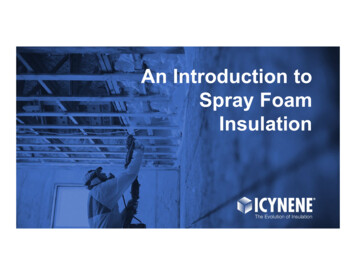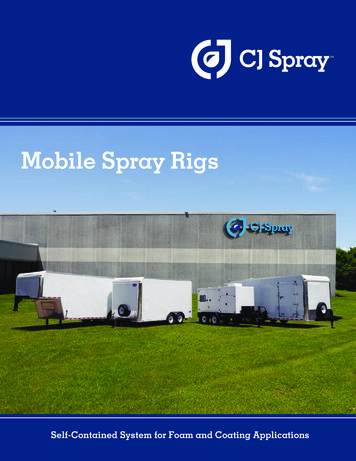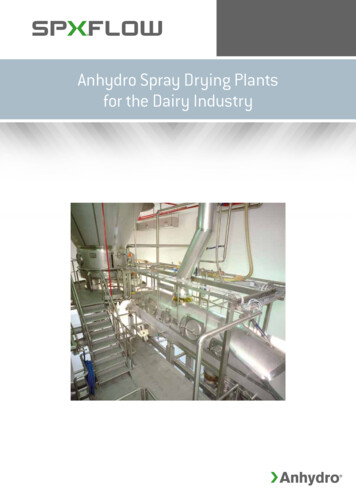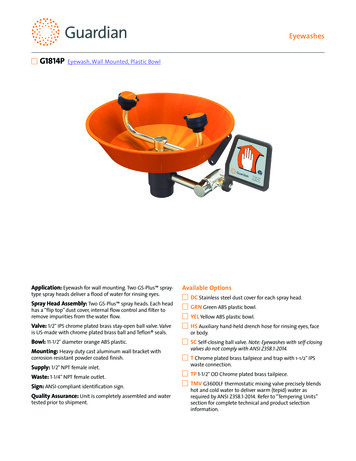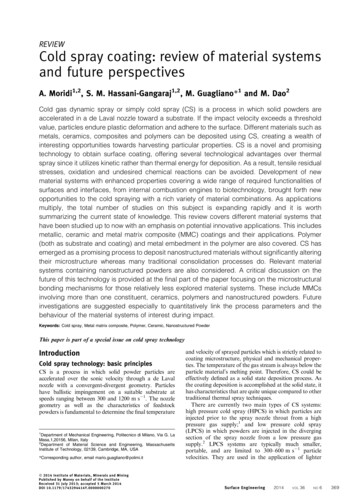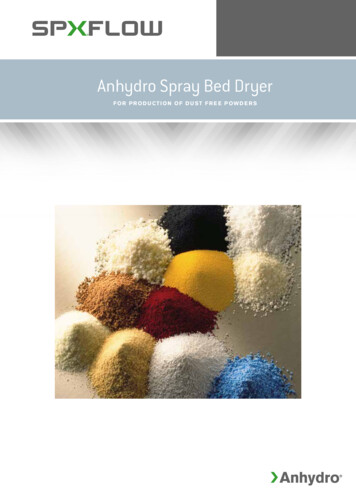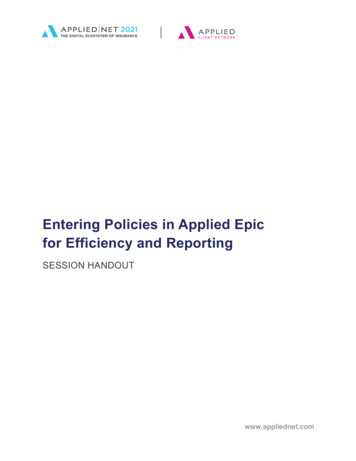
Transcription
STOROIL BUILBRIDCOMFundamentals of Spray-AppliedGeopolymer LiningsExtending the life of the world’s infrastructure.
FUNDAMENTALS OF SPRAY-APPLIEDGEOPOLYMER LININGSSTOROIL Fundamentals of Spray-AppliedGeopolymer LiningsBUILDBRIDCOMIn the 2017 Infrastructure Report Card, the American Society of Civil Engineers(ASCE) issued a grade of D for the condition of the country’s wastewatersystems. ASCE classifies wastewater to include sewage treatment plants,sanitary sewer pipelines and collection systems, stormwater management andcombined sewer overflows (CSOs). The aged and decaying state of wastewatersystems is not only unique to the United States but is also a global concern.While many local and federal agencies around the world have begun to developasset management plans for their wastewater systems, and thousands of pipelinerehabilitations are conducted annually, one area of key concern is large-diameterwastewater pipelines. Typical dig-and-replace technologies are often not practicalbecause, in most urban areas, these degrading pipes are located directly undercritical infrastructure such as major roadways or other assets. As the diameter ofthese pipes becomes larger (more than 36 inches), the cost of many traditionaltrenchless technologies like cured-in-place pipe (CIPP) becomes exponentiallymore expensive and often requires significant excavation around access points thatpresent additional issues related to community disturbance, traffic control, noiseand general disruption. Other techniques like slip-lining would require an evengreater excavation diameter for an access hole to install new liners. Additionally,other issues related to either the shape (round, arched, elliptical) or the layout(straight, curved, bends of various radii) can make these repair technologiesimpractical.During the last decade, additional trenchless technologies have been developedto help fill the need for larger diameter pipe repairs at effective costs — all withlittle or no excavation requirements and minimal community disruptions. One suchtechnological advance is the use of centrifugally cast geopolymer mortars to createa new pipe inside of the existing pipe. This technique allows for a cementitiouspipe to be created within the existing structure, using the pipe as a form, and canbe designed so that a new and fully structural pipe is created. The flexibility of thetechnique allows for pipes of all shapes and layouts to be repaired either usingautomated mechanical casting or manually controlled material placement. Thenecessary equipment can easily fit down standard manholes and all excavationcan typically be avoided if there are access points located at least every 800linear feet.1
FUNDAMENTALS OF SPRAY-APPLIEDGEOPOLYMER LININGSSTOROIL History of GeopolymersBUILDGeopolymer is a term originally coined by French researcher Joseph Davidovits todescribe a class of “cement” formed from aluminosilicates. While ordinary portlandcement (OPC) — the most common type of cement used in building and construction— relies on the absorption of water to create its strength, geopolymers cure by formingmuch stronger covalent bonds between the molecules in the presence of a basic oralkaline environment. Geopolymers are commonly referred to in the industry as“alkali-activated cement” or “inorganic polymer concrete.” Geopolymers providecomparable or better performance to OPC in terms of physical properties, such ascompressive or tensile strengths, but with the added advantages of significantlyreduced greenhouse emissions, increased fire and chemical resistance and reducedwater utilization. The use of geopolymers in modern industrial applications has becomeincreasingly popular based on their intrinsic environmental and performance benefits.BRIDCOMGeopolymer structure of bonded networkThe structure of a geopolymer is a cross-linked inorganic polymer network consistingof covalent bonds between aluminum, silicon and oxygen molecules that form analuminosilicate backbone with associated metal ions. The materials that react to formthe geopolymer are also commonly referred to as pozzolanic materials. In contrast,OPC is a hydrated complex of small molecules that are not covalently bonded butassociated and held by the hydrogen bonding power of the water molecule. This isdone with no long chain covalently bonded backbone or network structure.Ordinary portland cement (OPC) chemistry withassociated water moleculesWhile there is no perfect test for determining that a geopolymer structure has formed,there is a simple rule of thumb that will ensure the material is not just a standard OPC.The complete mixture should contain at least 70 percent pozzolanic material. Atthis level of pozzolanic content, a standard OPC material would not adequately buildstrength. Typical pozzolanic molecules present are metal oxides such as Al2O3, SiO2,MgO and Fe2O3, among others.In 2011, Milliken Infrastructure Solutions, LLC (MIS) developed and introducedthe first geopolymer mortar material specifically designed for trenchlesswastewater rehabilitation: GeoSpray geopolymer mortar. The development ofgeopolymers for large-scale industry-applicable systems required the creationof a “just add water” mixture that avoided the necessity of alkaline solutionsused to create the proper reaction conditions. To date, more than 40 millionpounds of GeoSpray mortar have been applied successfully around the worldon more than 200 unique projects — totaling well over 100,000 linear feet oflarge-diameter pipelines.GeoSpray geopolymer mortar was the firstgeopolymer mortar material designed fortrenchless wastewater rehabilitation.2
FUNDAMENTALS OF SPRAY-APPLIEDGEOPOLYMER LININGSSTOROIL Benefits of GeopolymersBUILDGeopolymer mortars provide some unique advantages when comparedto OPC mortars or other trenchless technologies such as CIPP or slip-lining.BRIDCOMFlexural StrengthGeopolymers and other cementitious materials, such as OPC, are typicallyconsidered rigid liners when compared to CIPP or slip-lining, which are classifiedas flexible liners. These liners will be designed differently based on their failuremodes. The failure mode of flexible liners is often buckling, while rigid liners likereinforced concrete pipes (RCPs) would fail by longitudinal cracking. The key designparameter of a rigid geopolymer lining would be flexural strength.The covalently bonded network of a geopolymer helps the materials develop higherflexural strength values as compared to OPC materials. In addition, inorganic fiberscan often be incorporated in the geopolymer formulation. These fibers react intothe system and become part of the polymer backbone, providing further benefitto an enhanced flexural strength. A properly formulated and cured geopolymermaterial can have between 25-50 percent higher flexural strength compared tostandard OPC formulations.Brick sewer before geopolymer mortarapplication.For cementitious materials, there are several standard test methods for flexuralstrength, so it is important that design engineers use the most conservativemethods when providing design values. Methods that apply third-point loading,such as ASTM C-78, give more conservative values and should be preferred ascompared to center point loading methods, such as ASTM C-293 or ASTM C-348.Rehabilitated sewer using GeoSpray mortar.3
STORFUNDAMENTALS OF SPRAY-APPLIEDGEOPOLYMER LININGSOIL Self-Bonding & Cold JointsBUILDOne of the major drawbacks of standard OPC materials is the common formation ofcold joints. Cold joints are undesired discontinuities between two layers of concretethat typically occur due to the inability of a freshly poured layer of wet cement tointermingle and bind with an already hardened layer. Geopolymer chemistry helpsavoid this issue. The condensation reaction that forms the geopolymer backboneis really a living chemistry, and new layers of material will directly react with theexisting pour materials no matter the amount of time between applications. Dueto practical job site constraints, most geopolymer and OPC pipe linings are placedin multiple lifts. However, the unique chemical nature of GeoSpray geopolymermortar helps ensure that those layers are intimately and chemically bonded, sothey do not become the weak point of the structure as they do with OPC.BRIDCOMDay 0Day 1Day 7Day 14Day 28GeoSpray geopolymer slant shear cylinderstested in compression don’t have cold joints.Chemical ResistanceIn sanitary sewage environments, cementitious materials are susceptible to adegradation process known as microbial-induced corrosion (MIC), which might bereferred to as H2S corrosion. This is the typical cause for long-term failure of mostexisting large-diameter concrete sewer pipes. The H2S gas emitted from the sewereffluent is digested by microbes to create sulfuric acid, which attacks unreactedcalcium hydroxide in the cementitious material. OPC grouts contain between 2-5percent of free calcium hydroxide, a byproduct of the manufacturing process,which remains unreacted after the concrete is cured. Geopolymers typically containsignificantly less than 1 percent of the free calcium hydroxide, which makes themmore chemically resistant to the corrosion process thanOPC materials.Day 0Day 1Day 7Day 14Day 28Cylinders of common pipe rehab OPC productshear on the cold joint in all cases tested.Day 0Day 81Day 0Day 81OPC loses 50% of its mass when exposed to 7%sulfuric acid; geopolymer mortar is an order ofmagnitude better in performance.Mechanism of microbial-induced corrosion(MIC).4
FUNDAMENTALS OF SPRAY-APPLIEDGEOPOLYMER LININGSSTOROIL Environmentally FriendlyBUILDGeopolymers have a variety of environmental advantages compared to a widerange of pipe rehabilitation technologies.BRIDCOMGeopolymer advantages include: Styrene-free Greater than 75 percent reduction in greenhouse gasemissions from raw material production A significant percentage of post-industrial waste streamsAdditional trenchless advantages include: Minimal community disruptionExample geopolymer installation project site.View from truck. Little to no site excavation Greater than 50 percent reduction of greenhouse gasemissions from the installation processReliableMIS’s GeoSpray geopolymer mortar has been tested, investigated or certifiedby a variety of independent consultants and governing bodies including: US Environmental Protection Agency (US EPA) Water Research Center (WRc) – WRc Approval Water Regulations Advisory Scheme (WRAS) – WRAS Approved Australian Water Quality Centre – AS/NXS 4020: 2005 Drinking Water Contact Certified NSF/ANSI 61 Section 5 & NSF/ANSI 372 Drinking WaterCertifications for pipes greater than 6" diameter or tanks greaterthan 300 gallons More than 20 explicitly approved product listings (APL) for Departmentsof Transportation (DOTs) and local municipalities5
FUNDAMENTALS OF SPRAY-APPLIEDGEOPOLYMER LININGSSTOROIL CostBUILDIt has been well-established that the cost of trenchless technologies (wherea pipe can be repaired instead of replaced) is significantly lower than dig andreplace options in most urban environments. Estimates suggest that trenchlesstechnologies of any kind have between a 50-70 percent advantage over the cost ofopen-trench solutions. Among trenchless technologies, spray-applied geopolymerlinings are often the most cost-effective method for wastewater pipes withgreater than a 48" diameter. Geopolymers may also offer an advantage in smallerdiameters based on specific site details. As the pipe diameter increases, the costof repairs dramatically increases due to the cost of materials and labor required toclean, prepare and repair the pipe. Spray-applied geopolymer linings can often bebetween 20-50 percent less expensive in comparison to CIPP, the market’s leadingsolution for pipes larger than 60".BRID COMCIPP(Cured in Place Pipe)Sliplining(Materials & Labor)COST PER LINEAR FOOT SWP(Spiral Wound)GeoSprayGeopolymerMortar 667278849096102108114120PIPE DIAMETER IN INCHES6
FUNDAMENTALS OF SPRAY-APPLIEDGEOPOLYMER LININGSSTOROIL Geopolymer Lining ApplicationsBUILDTo date, spray-applied geopolymer linings have been used in a myriadof applications, including:BRIDCOM Host Pipe Sizes: 24" diameter to greater than 18' diameter Host Pipe Materials: Brick, Stacked Stone, Reinforced Concrete (RCP),Unreinforced Concrete, Corrugated Metal (CMP), HDPE, Steel,and Aluminum PlateCMP culvert Host Pipe Shape: Boxes, Arches, Egg-Shaped, Elliptical, Round Host Pipe Applications: Sanitary, Storm, Culverts, Manholes,Drinking Water, Industrial, Gravity, Force Main Host Pipe Features: Size changes, non-round, bends or curves anyangle, missing inverts, less than 10 percent deflectedGeopolymer Application Process:Prior to the spray application of a geopolymer lining, the host pipe is cleaned inplace, typically with high-pressure water-blasting of 3,500 psi or more. To ensureadhesion of the geopolymer to the damaged substrate, it is sometimes necessaryto perform an additional cleaning with an environmentally friendly detergent toremove excess oil and grease from the existing pipe walls. If there are large leakingholes, the pipe can be plugged with a thin application of a plugging compound,hydraulic cement or chemical grout. Active water flow should be stopped.Brick culvertThe geopolymer mortar is usually centrifugally cast from atop a sled, which isslowly removed from the pipe to provide a uniform application. Typical applicationthicknesses range between 1-3" (25-75 mm), depending on the type of pipe, localsoil and water conditions, current condition of the existing pipe and the design liferequirements of the pipe in question. Hand-spray application for difficult-to-reachareas, host pipes greater than 10' in diameter and non-round shapes are commoncircumstances as well.Concrete culvertQuality Control:Geopolymer mortar applications typically have three levels of quality control: Internal manufacturing test of raw material quality and finalphysical property testing Field verification of compressive strength by certified third-partyindependent test labs Installer lead verification of application thicknessManhole7
FUNDAMENTALS OF SPRAY-APPLIEDGEOPOLYMER LININGSSTOROIL Engineering MethodologyBUILDMultiple third-party external firms, universities and research centers have testedand evaluated field-applied geopolymer liners. More than 60 lined pipe sampleshave been tested to failure to determine an appropriate engineering designmethodology for the proper structural thickness and design life. These studieshave been through a rigorous peer-reviewed process. All standalone structureapplications using GeoSpray geopolymer mortars are designed using thisconservative approach.BRIDCOMConclusionSpray-applied geopolymer mortar linings are quickly becoming the preferredstructural rehabilitation technology for large-diameter pipeline repairs. Witha significant advantage over traditional OPC materials and other trenchlessmethods, geopolymer repairs might just be the ideal solution for your wastewaterrehabilitation needs.If you are not sure or need more information to determine if spray-appliedgeopolymer mortar linings are the right choice for your project, MillikenInfrastructure Solutions engineers are available to answer any questions andconcerns. Contact us via our website, infrastructure.milliken.com, or by calling855-655-6750.Published papers are available upon request.Contact us at http://infrastructure.milliken.com/contact-us/, or call us at 855-655-6750.Extending the life of the world’s infrastructure.8
clean, prepare and repair the pipe. Spray-applied geopolymer linings can often be between 20-50 percent less expensive in comparison to CIPP, the market's leading solution for pipes larger than 60". CIPP (Cured in Place Pipe) Sliplining SWP COST PER LINEAR FOOT (Spiral Wound) (Materials & Labor) 66 72 78 84 90 96 102 108 .

